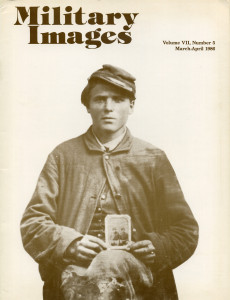The complete issue
Vol. VII, No. 5
(32 pages)
Print edition: Visit our store to check availability
Digital edition: Visit JSTOR.org to purchase
Subscribe to MI
Explore the MI Archives: Browse | Advanced search | Tutorial
Inside
Cover image
The front of this issue of Military Images features a soldier in kepi with a tintype image in his lap. He was 18 year old Freeman Mason of the 17th Vermont Infantry and the figure on the right in the tintype was his brother Michael. Both of the Mason brothers died in the service of their country.
Editor’s Desk (p. 1)
The editor notes a change in address for the magazine, and an increase in subscription prices due to rising costs of production and mailing. A preview of the upcoming issues was also outlined, based on popular issues of past issues.
Mail Call (p. 2)
The editor addresses a call for a rebuttal of a review of a publication in the September-October 1985 issue; the author and the reviewer have gone into litigation and the editor feels it best to refrain from comment. The author appears to have fraudulently gained access to the MI mailing list, and the editor requests that any communication be forwarded including the mailing label. A reader also questions the identity of the “oldest continuing military organization” in the U.S.
Passing in Review (pp. 3-4)
The current issue includes three reviews, beginning with The March to the Sea and Beyond by Joseph T. Glatthaar. The work looks at the Western Union soldier through the lens of Sherman’s Atlanta campaign. He looks at their views on the war, the South and slavery, and other issues on a more individual basis and discusses how these views changed during the campaign. The next review is of Touched by Fire: a Photographic Portrait of the Civil War, Volume I edited by William C. Davis. The reviewer does not give this volume very high marks. While nicely produced, it is not a recommended purchase. Cannoneers in Gray by Larry J. Daniel tells the story of the artillery branch of the Army of Tennessee and how these soldiers, at a disadvantage in many different ways, held up against their Northern opponents.
Vignette: Isaac Buswell, A patriot in the 20th N.Y.S.M. by Seward R. Osborne (p. 5)
“Ike” Buswell came from a family grounded in military service and he proved himself to be of the same patriotic cloth. He was taken prisoner in 1862 while taking a small expedition to find out what he could about Confederate secret mail service between Richmond and Fredericksburg, spending time in Libby Prison and Belle Isle. He was paroled, recuperated, promoted, and returned to the 20th only to be wounded on the first day of fighting at Gettysburg. His wounded leg became gangrenous, but he fought to keep his leg, returning once again to the 20th. The end of the war saw Ike Buswell with the rank of captain and part of the forces occupying Richmond at the end of the war.
Brady and Lee – 1866: The history of a photographic session by John O’Brien (pp. 6-8)
Complete with four different versions of on an iconic image, the author describes the history of the 1866 image of Robert E. Lee, the first postwar photograph that was often noted as being taken in Washington, D.C. in 1869. It was an image that Lee and the college he led (now known as Washington and Lee in Lexington, Virginia) wanted in order to show that he had moved on and was taking an active role in Reconstruction Virginia. It contrasts greatly with the 1865 image that Mathew Brady took of Lee on his porch in Richmond immediately after the surrender at Appomattox, also included with the article.
Vignette: Edwin Francis Johnson, a private in the 2nd Louisiana Infantry by Keith Bohannon (p. 9)
One of the most well-known images of the Civil War, the oval portrait of a very young Confederate soldier is often misidentified as belonging to a member of a Georgia regiment, although the kepi he wears bears the pelican insignia of Louisiana. The vignette describes his military career, ending with his death in July 1862 at Malvern Hill in Virginia.
Capt. Abraham Cottrell by Kean Wilcox (pp. 11-15)
He was both a photographer and a soldier, and a series of previously unpublished tintype images found in the effects of Capt. Cottrell have allowed the author to investigate both aspects of this soldier/photographer. Serving with the 8th Michigan Volunteer Infantry, Cottrell had been appointed as an aid-de-camp to General Isaac Stevens for his exceptional service in South Carolina in 1861. He was injured when his horse fell on him in early 1862, and eventually returned to serve as commander of Company E (“The Elder Zouaves”) of the 8th Michigan at Secessionville, South Carolina; his injuries in that battle, which initially saw him listed as killed in action, led to promotion and eventually a discharge for disability in March 1863. However, Cottrell returned to service later that same year as a lieutenant in the Invalid Corps, later renamed the Veterans Reserve Corps. His organizational abilities with the 16th Regiment of the VRC led to a promotion to captain, and a number of various independent command assignments. The article includes portraits of Cottrell, including some post-war cartes de visite and samples of backmarks he used with his work in Lansing, Michigan. The remaining images are of the four quarter plate tintypes found among Cottrell’s effects which feature a photographer working at some sort of ceremony.
Union Cavalry Carbines by Richard Carlile (pp. 16-26)
More than twenty images make up this informational pictorial article on the weapon that was favored by Union cavalry units. The carbine allowed the cavalry to fight mounted or dismounted, providing another weapon that could be effectively used by cavalry units. The problem was the vast number of different makes of carbine, each requiring a specific type of cartridge for its ammunition. The article discusses the main carbine brands used by the Union in the Civil War, and provides a chart that illustrates 16 different carbine types. The two most commonly used were the Sharps and the Burnside, with the seven-shot Spencer that appeared towards the end of the conflict. The images include many different types, including one of a Gallager; that particular make was popular, but not seen often in photographs.
To the Bitter End: Lt. David Raney, Confederate States Marines by David M. Sullivan (pp. 26-28)
A misidentification of an image led to the investigation of who the subject of the image was: Lt. David Raney, Jr., a native of Apalachicola, Florida, the first commissioned 2nd lieutenant in the Confederate States Marine Corps. Serving until the end of the war, he had a wide range of experiences from serving on the flagship of Commodore Tattnall during fighting at Port Royal to serving in the garrison at Drewry’s Point to commanding the Marines on the C.S.S. Tennessee and being captured at Mobile Bay. Raney escaped from prison in New Orleans and returned to Mobile to command Company D. Raney was with a group of his Marines when the C.S.S. Morgan surrendered on May 10, 1865, signing his parole papers for his men and for himself. Raney never did quite recover from the loss of the Confederacy, ending up a recluse in his family home in Apalachicola for the remainder of his life.
Stragglers (pp. 30-31)
Images submitted for inclusion in this issue of Military Images includes two views of the Inaugural Parade for President Taft in March 1909, including a mountain battery unit loaded on mules. An officer of the day from the Connecticut National Guard is also included, as is an 1888 image of the Lisbon, Ohio militia battery. The same gun is on display in the town’s village square.
Back Image
A fully armed Union soldier, including a Model-1859 Sharps carbine.





































